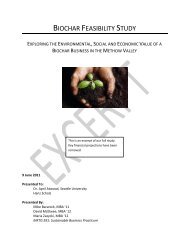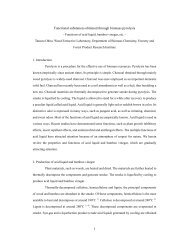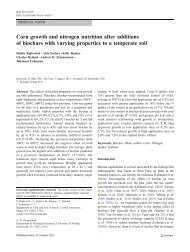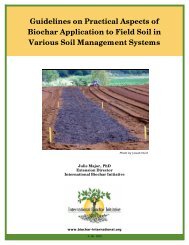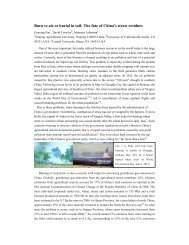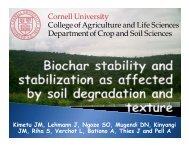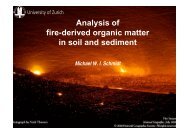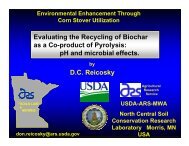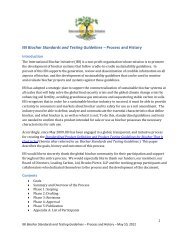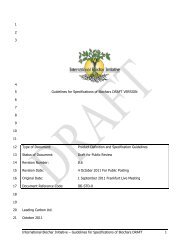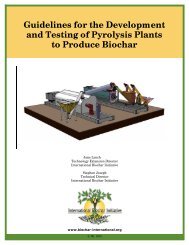Guidelines for Specifications of Biochars for Use in Soils FINAL ...
Guidelines for Specifications of Biochars for Use in Soils FINAL ...
Guidelines for Specifications of Biochars for Use in Soils FINAL ...
You also want an ePaper? Increase the reach of your titles
YUMPU automatically turns print PDFs into web optimized ePapers that Google loves.
12345678910111213141516171819202122232425262728293031biochar, as follows: where the TMECC methodology recommends a 1:5 v:v or w:w 4 solution <strong>of</strong>compost : deionized water, a 1:20 w:w or v:v solution <strong>of</strong> biochar : deionized water should beused <strong>for</strong> biochar pH and EC analysis, follow<strong>in</strong>g Rajkovich et al (2011). Similarly, additional timeshould be allotted <strong>for</strong> solution equilibration after the comb<strong>in</strong>ation <strong>of</strong> deionized water andbiochar. Follow<strong>in</strong>g Rajkovich et al (2011), 1.5 hours should be provided <strong>for</strong> the shak<strong>in</strong>g andequilibration <strong>of</strong> biochar-deionized-water solutions prior to pH and EC analysis. Upon completion<strong>of</strong> the shak<strong>in</strong>g and equilibration phase, pH and EC analysis may be conducted on the samesamples, rather than mak<strong>in</strong>g separate replicates <strong>for</strong> pH and EC. To complete the pH and ECanalysis follow methodologies 04.10 and 04.11 <strong>of</strong> the TMECC methodology (US Compost<strong>in</strong>gCouncil and US Department <strong>of</strong> Agriculture (2001)).Earthworm Avoidance and Germ<strong>in</strong>ation Inhibition AssayThe Earthworm Avoidance and Germ<strong>in</strong>ation Inhibition Assay analyses follow proceduresoutl<strong>in</strong>ed by Van Zwieten et al 2010. The recommended approach <strong>for</strong> biochar analysis is t<strong>of</strong>ollow Van Zwieten et al’s methods, as they are drawn from the <strong>in</strong>itial 1984 OECD and ISO17512 - 1:2008 methodologies, and to report earthworm behavior as it relates to the avoidance<strong>of</strong> biochar-soil, and seedl<strong>in</strong>g germ<strong>in</strong>ation as it relates to the failure to germ<strong>in</strong>ate <strong>in</strong> biochar-soil.Lettuce (Lactuca sativa L.) is the most widely recommended species to use <strong>in</strong> germ<strong>in</strong>ationassessments, due to its sensitivity. Other species that can be used are found with<strong>in</strong> the OECD(1984b) methodology. The primary approach to the earthworm avoidance test is drawn fromISO 17512 – 1:2008, with <strong>in</strong>structions on soil matrix blend<strong>in</strong>g from the OECD (1984a)methodology. Further augmentations <strong>of</strong> Van Zwieten et al’s approach should follow Li et al(2011) to ensure that adequate wett<strong>in</strong>g <strong>of</strong> soil and biochar-soil blends is achieved <strong>for</strong> theduration <strong>of</strong> the Earthworm Avoidance test. Results should be reported as a “fail” to reflect astatistically significant preference <strong>of</strong> the worms to avoid biochar-blended soils, or a failure <strong>of</strong>seedl<strong>in</strong>g germ<strong>in</strong>ation and growth <strong>in</strong> biochar-blended soils, thus reject<strong>in</strong>g the null-hypothesisthat there is no difference between biochar-soil blends and soil with<strong>in</strong> the test. Results can bereported as a “pass” where there is no difference <strong>of</strong> worm preference or germ<strong>in</strong>ation andseedl<strong>in</strong>g growth success between biochar-soil blends and soil, or where biochar-soil blends arepreferred; both conditions are considered to pass these tests. The purpose <strong>of</strong> the analyses is todeterm<strong>in</strong>e whether add<strong>in</strong>g biochar to soil has an effect on worm behaviour and seed4 v:v – volume:volume denotes a ratio situation where the annotation is anticipat<strong>in</strong>g equivalentunits <strong>of</strong> volume measurement <strong>in</strong> a dilution or blend (e.g. a 1:5 v:v biochar:water blend could<strong>in</strong>dicate the need to blend 1L <strong>of</strong> biochar with 5L <strong>of</strong> water)w:w – weight:weight denotes a ratio situation where the annotation anticipates equivalent units<strong>of</strong> weight measurement <strong>in</strong> a dilution or blend (e.g. a 1:5 w:w biochar:soil blend could <strong>in</strong>dicatethe need to blend 1 kg <strong>of</strong> biochar with 5 kg <strong>of</strong> soil)International Biochar Initiative – <strong>Guidel<strong>in</strong>es</strong> <strong>for</strong> <strong>Specifications</strong> <strong>of</strong> <strong>Biochars</strong> <strong>for</strong> <strong>Use</strong> <strong>in</strong> <strong>Soils</strong> 25



